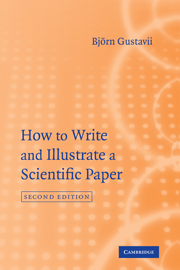Book contents
- Frontmatter
- Contents
- Preface
- Acknowledgments
- 1 Basic rules of writing
- 2 Comments on scientific language
- 3 Drafting the manuscript
- 4 Choosing a journal
- 5 Preparing a graph
- 6 Drawings
- 7 Figure legends
- 8 How to design tables
- 9 Title
- 10 Authors
- 11 Abstract
- 12 Introduction
- 13 Methods
- 14 Results
- 15 Discussion
- 16 Acknowledgments
- 17 References
- 18 Ph.D. and other doctoral theses
- 19 Letters and case reports
- 20 Numbers
- 21 Abbreviations
- 22 How to present statistical results
- 23 Typing
- 24 Dealing with editors and referees
- 25 Correcting proofs
- 26 Authors‘ responsibilities
- Literature needed on your desk
- Further reading
- Literature cited
- Index
25 - Correcting proofs
Published online by Cambridge University Press: 05 June 2012
- Frontmatter
- Contents
- Preface
- Acknowledgments
- 1 Basic rules of writing
- 2 Comments on scientific language
- 3 Drafting the manuscript
- 4 Choosing a journal
- 5 Preparing a graph
- 6 Drawings
- 7 Figure legends
- 8 How to design tables
- 9 Title
- 10 Authors
- 11 Abstract
- 12 Introduction
- 13 Methods
- 14 Results
- 15 Discussion
- 16 Acknowledgments
- 17 References
- 18 Ph.D. and other doctoral theses
- 19 Letters and case reports
- 20 Numbers
- 21 Abbreviations
- 22 How to present statistical results
- 23 Typing
- 24 Dealing with editors and referees
- 25 Correcting proofs
- 26 Authors‘ responsibilities
- Literature needed on your desk
- Further reading
- Literature cited
- Index
Summary
Popeye, the beloved cartoon character, would probably never have been created had it not been for a misplaced decimal point. As you know, Popeye gets his strength by eating spinach, assumed to be rich in iron. This misconception derives from a report indicating, due to a misplaced decimal point, that spinach has an iron content tenfold higher than its true value. An overlooked error seldom has such amusing consequences, however.
How to read proof
When you receive your masterpiece, nicely typeset in the form of a proof, you may be tempted to read it straight through at that very moment. My advice is to follow your intuition. You will be on the alert and will easily notice if the reading makes sense, thus catching errors of omission, such as a dropped line or a lost paragraph. In order not to overlook printer's errors, however, you will have to reread the proof at least once more.
For the second reading, persuade someone to slowly read the manuscript aloud while you check the text in the proof. If you can't find a reader, place a finger under the first line of the manuscript and a finger under the first line of the proof, just under the first character. Look from manuscript to proof and back again, checking word by word, numeral by numeral, and punctuation mark by punctuation mark. Be especially careful in checking the tables and the reference list.
- Type
- Chapter
- Information
- How to Write and Illustrate a Scientific Paper , pp. 137 - 141Publisher: Cambridge University PressPrint publication year: 2008



